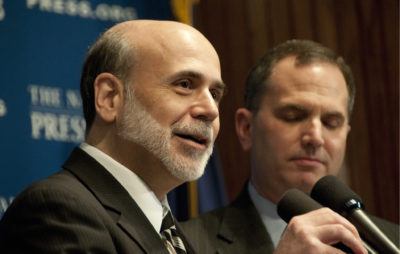Ben Bernanke, Austrian macro economist
The Fed and its officials take a lot of flak from those working in the tradition of Mises and Hayek. I’ve been known to dish the dirt (occasionally with the likes of Peter Boettke and Steve Horwitz). And, given its track record, criticism is certainly warranted. But self-styled Austrians should be careful not to go too far.
In particular, self-styled Austrians have a tendency to overstate the differences in the Austrian business cycle theory and that of so-called mainstream economists. Consider this recent comment by former Fed Chair Ben Bernanke:
To understand why this is so, it helps to introduce the concept of the equilibrium real interest rate (sometimes called the Wicksellian interest rate, after the late-nineteenth- and early twentieth-century Swedish economist Knut Wicksell). The equilibrium interest rate is the real interest rate consistent with full employment of labor and capital resources, perhaps after some period of adjustment. […]
If the Fed wants to see full employment of capital and labor resources (which, of course, it does), then its task amounts to using its influence over market interest rates to push those rates toward levels consistent with the equilibrium rate, or—more realistically—its best estimate of the equilibrium rate, which is not directly observable. If the Fed were to try to keep market rates persistently too high, relative to the equilibrium rate, the economy would slow (perhaps falling into recession), because capital investments (and other long-lived purchases, like consumer durables) are unattractive when the cost of borrowing set by the Fed exceeds the potential return on those investments. Similarly, if the Fed were to push market rates too low, below the levels consistent with the equilibrium rate, the economy would eventually overheat, leading to inflation—also an unsustainable and undesirable situation. The bottom line is that the state of the economy, not the Fed, ultimately determines the real rate of return attainable by savers and investors. The Fed influences market rates but not in an unconstrained way; if it seeks a healthy economy, then it must try to push market rates toward levels consistent with the underlying equilibrium rate.
To me, that statement does not sound fundamentally at odds with the Austrian view. Indeed, I think Bernanke’s underlying model of the macroeconomy is similar to that employed by Austrians.
Do you think the model employed by Bernanke is fundamentally at odds with the Austrian view? If so, in what way? Would you describe this as a difference in kind or degree? In an effort of full disclosure, I will admit that I am not particularly wedded to the Austrian title. I’d rather focus on doing good macroeconomics. I believe much can be learned from the works of Mises and Hayek. But I do not believe they provide the final word on the subject. Nor do I believe that those less familiar with their works are necessarily incapable of doing good macroeconomics. Indeed, we might learn a thing or two by seriously considering the views of Bernanke and others.










